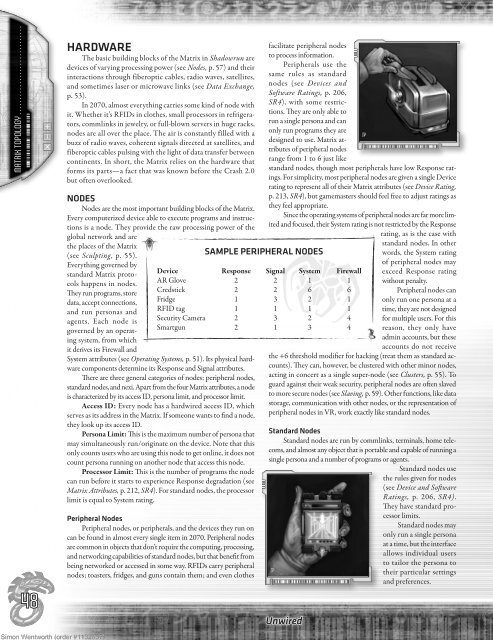comStar Firewall alert - PhaseThrough
comStar Firewall alert - PhaseThrough
comStar Firewall alert - PhaseThrough
You also want an ePaper? Increase the reach of your titles
YUMPU automatically turns print PDFs into web optimized ePapers that Google loves.
Matrix topoloGy . . . . . . . . . . . . . . . . . . . . . . . . . . . . .<br />
48<br />
Hardware<br />
The basic building blocks of the Matrix in Shadowrun are<br />
devices of varying processing power (see Nodes, p. 57) and their<br />
interactions through fiberoptic cables, radio waves, satellites,<br />
and sometimes laser or microwave links (see Data Exchange,<br />
p. 53).<br />
In 2070, almost everything carries some kind of node with<br />
it. Whether it’s RFIDs in clothes, small processors in refrigerators,<br />
commlinks in jewelry, or full-blown servers in huge racks,<br />
nodes are all over the place. The air is constantly filled with a<br />
buzz of radio waves, coherent signals directed at satellites, and<br />
fiberoptic cables pulsing with the light of data transfer between<br />
continents. In short, the Matrix relies on the hardware that<br />
forms its parts—a fact that was known before the Crash 2.0<br />
but often overlooked.<br />
nodeS<br />
Nodes are the most important building blocks of the Matrix.<br />
Every computerized device able to execute programs and instructions<br />
is a node. They provide the raw processing power of the<br />
global network and are<br />
the places of the Matrix<br />
(see Sculpting, p. 55).<br />
Everything governed by<br />
standard Matrix protocols<br />
happens in nodes.<br />
They run programs, store<br />
data, accept connections,<br />
and run personas and<br />
agents. Each node is<br />
governed by an operating<br />
system, from which<br />
it derives its <strong>Firewall</strong> and<br />
System attributes (see Operating Systems, p. 51). Its physical hardware<br />
components determine its Response and Signal attributes.<br />
There are three general categories of nodes: peripheral nodes,<br />
standard nodes, and nexi. Apart from the four Matrix attributes, a node<br />
is characterized by its access ID, persona limit, and processor limit.<br />
Access ID: Every node has a hardwired access ID, which<br />
serves as its address in the Matrix. If someone wants to find a node,<br />
they look up its access ID.<br />
Persona Limit: This is the maximum number of persona that<br />
may simultaneously run/originate on the device. Note that this<br />
only counts users who are using this node to get online, it does not<br />
count persona running on another node that access this node.<br />
Processor Limit: This is the number of programs the node<br />
can run before it starts to experience Response degradation (see<br />
Matrix Attributes, p. 212, SR4). For standard nodes, the processor<br />
limit is equal to System rating.<br />
SaMpLe peripHeraL nodeS<br />
Device Response Signal System <strong>Firewall</strong><br />
AR Glove 2 2 1 1<br />
Credstick 2 2 6 6<br />
Fridge 1 3 2 1<br />
RFID tag 1 1 1 1<br />
Security Camera 2 3 2 4<br />
Smartgun 2 1 3 4<br />
peripheral nodes<br />
Peripheral nodes, or peripherals, and the devices they run on<br />
can be found in almost every single item in 2070. Peripheral nodes<br />
are common in objects that don’t require the computing, processing,<br />
and networking capabilities of standard nodes, but that benefit from<br />
being networked or accessed in some way. RFIDs carry peripheral<br />
nodes; toasters, fridges, and guns contain them; and even clothes<br />
facilitate peripheral nodes<br />
to process information.<br />
Peripherals use the<br />
same rules as standard<br />
nodes (see Devices and<br />
Software Ratings, p. 206,<br />
SR4), with some restrictions.<br />
They are only able to<br />
run a single persona and can<br />
only run programs they are<br />
designed to use. Matrix attributes<br />
of peripheral nodes<br />
range from 1 to 6 just like<br />
standard nodes, though most peripherals have low Response ratings.<br />
For simplicity, most peripheral nodes are given a single Device<br />
rating to represent all of their Matrix attributes (see Device Rating,<br />
p. 213, SR4), but gamemasters should feel free to adjust ratings as<br />
they feel appropriate.<br />
Since the operating systems of peripheral nodes are far more limited<br />
and focused, their System rating is not restricted by the Response<br />
rating, as is the case with<br />
standard nodes. In other<br />
words, the System rating<br />
of peripheral nodes may<br />
exceed Response rating<br />
without penalty.<br />
Peripheral nodes can<br />
only run one persona at a<br />
time, they are not designed<br />
for multiple users. For this<br />
reason, they only have<br />
admin accounts, but these<br />
accounts do not receive<br />
the +6 threshold modifier for hacking (treat them as standard accounts).<br />
They can, however, be clustered with other minor nodes,<br />
acting in concert as a single super-node (see Clusters, p. 55). To<br />
guard against their weak security, peripheral nodes are often slaved<br />
to more secure nodes (see Slaving, p. 59). Other functions, like data<br />
storage, communication with other nodes, or the representation of<br />
peripheral nodes in VR, work exactly like standard nodes.<br />
Standard nodes<br />
Standard nodes are run by commlinks, terminals, home telecoms,<br />
and almost any object that is portable and capable of running a<br />
single persona and a number of programs or agents.<br />
Standard nodes use<br />
the rules given for nodes<br />
(see Device and Software<br />
Ratings, p. 206, SR4).<br />
They have standard processor<br />
limits.<br />
Standard nodes may<br />
only run a single persona<br />
at a time, but the interface<br />
allows individual users<br />
to tailor the persona to<br />
their particular settings<br />
and preferences.<br />
Unwired<br />
Simon Wentworth (order #1132857) 9


